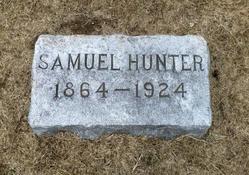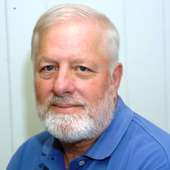Opinion
A Pitch in Time
Wednesday, October 2, 2013

Samuel Hunter's tombstone.
Baseball has always been a popular sport in our area with several area players having successful careers in college, and the minor and major baseball leagues. But have you ever heard of the remarkable baseball career of Sam Hunter of New Madrid?
The first name "Samuel" is a popular name in the Hunter family, so to clarify, the "Sam Hunter" I am writing about was born in 1864 to Samuel and Mary Anna Lewis Hunter. He was a brother to Lewis Ferguson, who was the father of Samuel Latham Hunter Sr., founder of the Bank of New Madrid.
Sam grew up just after the Civil War near New Madrid on his parents' farm near present day LaForge. Baseball had become the national pastime in the 1850s and was very popular during Sam's youth. He attended Westminster College in Fulton, Missouri, and played on its baseball team.
About 65 years ago the St. Louis Post wrote an editorial about the use of the curve ball in baseball. Charles H. Lemkin, alumni secretary emeritus of Westminster College, wrote a response to the paper. The article was reprinted in the October 27, 1950, issue of The Weekly Record.
Lamkin wrote:
One of the first curve ball pitchers in this section was Sam Hunter of New Madrid, pitching on the Westminster College team, his catcher being William Southern, Jr., now editor of the Independence Intelligencer.
A famous game between Westminster and the University of Missouri in the spring of 1882 was protested by the captain of the Missouri nine because "Hunter was not throwing a straight ball." The story is told this way in "A Great Small College." Lamkin, pp. 190-192:
Sam Hunter of New Madrid was a baseball pitcher of more than ordinary ability; his catcher was William Southern of Independence, who in later life has frequently stated that his major scholastic activity while attending Westminster was baseball. It was discovered that Sam could throw a curve; a thing then unheard of in Missouri collegiate circles if not in the state. Hunter practiced religiously and mastered such perfect control that he became as accurate in his throwing as the left-handed slingers of the tribe of Benjamin.
The most important, indeed almost the only, game of the year was with the University of Missouri. Hunter's curve ball was a secret, the Westminster team being anxious to compliment their rivals by letting them be the first to observe Sam's uncanny ability to make a baseball perform.
The game opened with nothing happening out of the ordinary except that the first three Missouri batters struck out. The third of these gentlemen, a rough and ready type of individual, claimed that Southern reached in front of his bat and caught the ball before he could hit it, and truculently told Southern that the next time he did that he would use his bat on the catcher's head.
When this player again came up to the bat he again struck out and, quickly turning, did as he had threatened, belting Southern, whose bald scalp shows the scar to this day. After first aid treatment had been administered, Bill Southern did not quit but stayed in the game. Being of a peaceful and forgiving disposition, he made no protest and his assailant was still permitted to play.
When the pugnacious player again came to the bat, Bill suddenly remembered the recent injury and signaled Sam to throw a certain ball which came forcibly and accurately, catching the university player on the upper arm, effectually putting him out of the line-up for the rest of the season. It is a remarkable circumstance that no other Missouri player was hit during the whole course of the day.
About the fifth inning the captain of the Missouri nine took a position behind Southern to see why his sluggers were so regularly striking out. What he saw filled him with indignation and he loudly proclaimed that Hunter was using illegitimate means to win, as he "was not throwing a straight ball." It seems to be unquestionable that Hunter was the first college pitcher in this state of master the curve.
Sam's accomplishment aroused comment in faculty circles as well as on the diamond. Dr. Lyle is said to have insisted that a curve could not be thrown; Dr. Scott was equally sure that it was possible to throw one. This dispute grew to a point where the professors decided to put the matter to the test.
Surveying instruments were taken to the baseball field; a straight line was accurately determined and on that line, between the pitchers box and the catcher, three stakes were driven. Dr. Lyle was amazed, discomfited, [unreadable word], to see Sam throw an "out" and then an "in" with each landing squarely in the hands of the redoubtable Southern.
Should anyone doubt this story Col. William Southern has a scar on his head to vouch for the truth of it and Mr. Josiah G. Moore of Mexico will elaborate for he was there and he saw it all. However, it is certain that throwing a curve ball was almost unknown anywhere in 1885 when the above game was played.
Publisher Camp wrote an article "Baseball for the Spectators," which was published in the Century Magazine in 1899. In that article Camp said: "For a long time men versed in physical science pooh-poohed at this. Saying it was impossible to throw a curve, that is was just an optical illusion. But the ball did curve and the first pitcher to acquire the art proved a problem to the batsman."
At another place in his article Camp intimates that at the time he wrote, curve balls had not been known long, possibly not more that a very few years even in the most advanced baseball circles; so Sam Hunter must have been one of the first men in the country to pitch a curve.
The real curve about this story is that there are a great many things about New Madrid that we have yet to discover.


